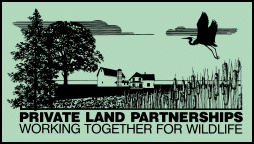 |
|
GRASSLAND BIRDS
|
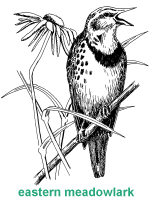 Grassland
habitats support a large variety of birds. Before European settlement, southern Michigan grasslands were largely dry
prairies, oak savannas, and wet meadows. During the settlement of Michigan, expansive, open prairies disappeared quickly as they were converted to farmland due to their rich soils. Wet meadows were drained and also made into productive agriculture lands. Michigan once had 70,000 acres of
upland prairies and 350,000 acres of wet prairies. Today, they have been reduced to fewer than 2,000 acres. Grassland
habitats support a large variety of birds. Before European settlement, southern Michigan grasslands were largely dry
prairies, oak savannas, and wet meadows. During the settlement of Michigan, expansive, open prairies disappeared quickly as they were converted to farmland due to their rich soils. Wet meadows were drained and also made into productive agriculture lands. Michigan once had 70,000 acres of
upland prairies and 350,000 acres of wet prairies. Today, they have been reduced to fewer than 2,000 acres.
Over the past 25 years, grassland bird populations have declined in North America more than any other group of birds. This decline is due to
fragmentation and loss of habitat. Habitat fragmentation occurs when large blocks of habitat are broken up by human development such as roads, trails, powerlines, homes, farms, and other disturbances. In Michigan, two
species that have been extirpated due to these impacts are the greater prairie chicken and lark sparrow.
Succession
Large grasslands support more bird species than small grasslands. Because of the massive decline of
native grasslands in Michigan, it is critical to grassland bird survival that large blocks of this habitat be maintained and managed. Before management begins, it is necessary to understand the natural progressions that occur on the
landscape over time.
"Succession" is the word used to describe these natural progressions. Over time, an area changes from
annual plants to perennial plants to
shrubs to forests. Succession can be set back or moved forward naturally (wildfire, windthrow, flooding, disease) or through human disturbance
(prescribed burning, mechanical and chemical treatments).
As habitats change, different types of wildlife are attracted to them. For example, a large meadow will provide nesting cover for bobolinks, but when woody plants begin to emerge the bobolinks will no longer use it. However, now American goldfinches will appear. Therefore, to manage for grassland birds you will need to prevent succession from proceeding too far into the shrub stage by maintaining a mix of annual and/or perennial grasses and
forbs.
Annual
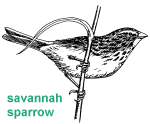 plants include weeds such as lamb's quarters, ragweed, mare's tail, and foxtail, and
grasses such as quack grass and switchgrass. Perennial plants include goldenrod, asters, daisy fleabane, brome, timothy, switchgrass, Indiangrass, and big bluestem. plants include weeds such as lamb's quarters, ragweed, mare's tail, and foxtail, and
grasses such as quack grass and switchgrass. Perennial plants include goldenrod, asters, daisy fleabane, brome, timothy, switchgrass, Indiangrass, and big bluestem.
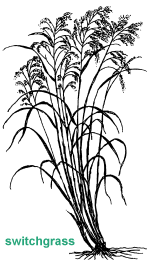 Warm season grasses are the most productive of cover types for grassland birds. Big and little bluestem, Indiangrass, and switchgrass are examples of warm season prairie grasses, which grow most rapidly during summer's peak when warm nights follow hot days. Because these
prairie grasses stand up well to snow, they provide
thermal cover for roosting birds and other wildlife. Consider mixing the grasses with forbs (native, flowering herbaceous plants such as wildflowers) to provide wildlife food and perches for songbirds. Black-eyed Susan, blazing star,
coreopsis, wild bergamot, and coneflower are some examples of these forbs. Big bluestem, Indiangrass, and switchgrass are examples of tall prairie grasses. Short prairie grasses include little bluestem and prairie
dropseed. Warm season grasses are the most productive of cover types for grassland birds. Big and little bluestem, Indiangrass, and switchgrass are examples of warm season prairie grasses, which grow most rapidly during summer's peak when warm nights follow hot days. Because these
prairie grasses stand up well to snow, they provide
thermal cover for roosting birds and other wildlife. Consider mixing the grasses with forbs (native, flowering herbaceous plants such as wildflowers) to provide wildlife food and perches for songbirds. Black-eyed Susan, blazing star,
coreopsis, wild bergamot, and coneflower are some examples of these forbs. Big bluestem, Indiangrass, and switchgrass are examples of tall prairie grasses. Short prairie grasses include little bluestem and prairie
dropseed.
Cool season
grasses, such as timothy grass, orchardgrass, and Canada wild-rye, and legumes such as medium-red clover and alfalfa grow most rapidly during spring and early summer and again at the end of summer when cool nights follow warm days. These grasses provide a variety of cover and food for grassland birds, and are considered short to intermediate grasses. Cool season grasses are best planted in conjunction with adjacent warm season prairie grasses.
Species Preferences
Depending on the grassland bird, each species may prefer a certain type of grass or grass/forb mix. Many species prefer around 75% grasses and 25% forbs, such as the dickcissel, song sparrow, horned lark, and upland sandpiper. Northern bobwhite quail prefer half and half. Whereas the Henslow’s sparrow, and common yellowthroat prefer a minimum amount of forbs.
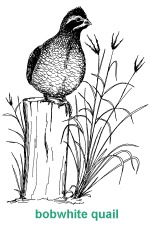 In addition, certain grassland birds are attracted to specific grass heights. This refers not only to the natural height of the grasses themselves, but also the height of the grasses due to human or natural disturbance. For instance, killdeer prefer very short grasses and sparse open areas. These usually include plowed agricultural and early stage old fields. The upland sandpiper, and horned lark are found in short grasses such as newly planted row crops and grasses, recently mowed hayfields, and old fields. Grasses intermediate to tall in height such as late stage old fields, uncut hayfields, and established prairies attract the eastern meadowlark, dickcissel, bobolink, and field and savannah sparrows. In addition, certain grassland birds are attracted to specific grass heights. This refers not only to the natural height of the grasses themselves, but also the height of the grasses due to human or natural disturbance. For instance, killdeer prefer very short grasses and sparse open areas. These usually include plowed agricultural and early stage old fields. The upland sandpiper, and horned lark are found in short grasses such as newly planted row crops and grasses, recently mowed hayfields, and old fields. Grasses intermediate to tall in height such as late stage old fields, uncut hayfields, and established prairies attract the eastern meadowlark, dickcissel, bobolink, and field and savannah sparrows.
This chapter characterizes grassland birds as species that utilize grasses at some point throughout the year. These species can also be distinguished into two groups: grassland dependent and independent. Dependent species use grasslands for all of their habitat needs. Independent species use grasses for one or two habitat components while also utilizing other areas, such as forests or
wetlands, for their habitat needs. For example, the American goldfinch prefers shrubs and small trees along with intermediate grasses to fulfill its habitat needs. The grasses are used for food and nesting materials. An example of a grassland dependent species is the eastern meadowlark. It only utilizes grasslands for all of its habitat needs.
Edge-sensitivity
Grassland birds also have a preference for the amount of unfragmented habitat available.
Edge-sensitive grassland birds are those with the lowest tolerance for fragmented habitat. These are also usually the species that prefer only grasslands (grassland dependent species). Conversely, species that live in more than one habitat usually have low sensitivity to edge.
Increasing edge for a certain wildlife species will also detrimentally impact other wildlife species. When grasslands are fragmented, many grassland birds are subjected to nest predation from crows, jays, skunks, raccoons,
opossums, foxes, and cats. This problem reiterates the importance of expansive grasslands for the survival of declining grassland bird species.
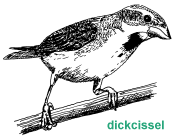 Grassland birds that are edge-sensitive include the upland sandpiper, bobolink, and savannah and Henslow’s sparrows. The eastern meadowlark and grasshopper sparrow are moderately sensitive to habitat fragmentation. Due to their
sensitivity and the increase in fragmentation, many of these species are declining or no longer exist in southern Michigan. Grassland birds that are edge-sensitive include the upland sandpiper, bobolink, and savannah and Henslow’s sparrows. The eastern meadowlark and grasshopper sparrow are moderately sensitive to habitat fragmentation. Due to their
sensitivity and the increase in fragmentation, many of these species are declining or no longer exist in southern Michigan.
Grassland birds that are tolerant to an abundance of edge include the northern bobwhite
quail, red-winged blackbird, American goldfinch, vesper, field, and song sparrows, dickcissel, and common yellowthroat.
Management Considerations
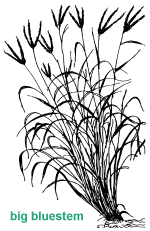 It is important to take a community or landscape approach to your management. If you own only a small grassland, it may help to determine what the surrounding landscape looks like. If other grasslands or agricultural lands are present, then it may be feasible for you to manage for grassland birds. However, if your grassland is surrounded by forest, you may want to consider other goals. It is important to take a community or landscape approach to your management. If you own only a small grassland, it may help to determine what the surrounding landscape looks like. If other grasslands or agricultural lands are present, then it may be feasible for you to manage for grassland birds. However, if your grassland is surrounded by forest, you may want to consider other goals.
Although most of Michigan's original grasslands no longer exist, there are opportunities available to help grassland birds. Federal and State conservation programs are helping to increase grasslands by setting aside land that had been actively farmed. Some good ways to maintain grasslands in agricultural landscapes is through pastures, old fields left idle, and protecting vast, open meadows. Also, for those within smaller, parcels, prairie plantings in your yard may be beneficial to those tolerant species that do not only need grasslands.
The following management guidelines will not necessarily guarantee the presence or absence of certain species. Restoring and enhancing existing grasslands, and reducing fragmentation are the best management options for grassland birds. Whenever you increase the size of a grassland, you will increase the likelihood that grassland birds will benefit. Therefore, the larger the grassland, the more species it will support.
The following are options to consider when managing for grassland birds:
- To manage for edge-sensitive species, you will need a minimum of 20 acres. Moderately sensitive species need between 10 and 20 acres, and tolerant species need less than 10 acres. These estimates are the minimum amounts these species need to survive. Again, the larger the grassland, the better.
- Avoid fragmenting existing grassland areas. If hiking trails are to be developed, restrict activities to the edges of the area. Avoid maintaining
hedgerows that may serve as
predator perches.
- Minimize the amount of linear edge by avoiding irregular borders. Circular tracts are ideal.
-
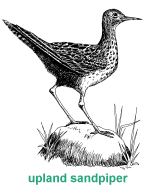 If large tracts of grassland
restorations are not possible, establish several patches. Try to incorporate adjacent grassy habitats such as pastures,
hayfields, and grassy waterways as connections between the grassland patches or as non-wooded, open edges. If large tracts of grassland
restorations are not possible, establish several patches. Try to incorporate adjacent grassy habitats such as pastures,
hayfields, and grassy waterways as connections between the grassland patches or as non-wooded, open edges.
- Maintain succession in its earliest stages by managing for grasses and sparse shrubs. Manipulations such as burning and mowing are required to maintain grass productivity typically within three to five year intervals.
- Manipulate your grasslands in 1/3 to 1/4 annual rotations. If several fields are maintained, it is better to manipulate one entire field, rather than a portion of each field per rotation. This will reduce fragmentation of your grasslands. However, if you have only one field, do not manipulate the entire field at once as it will displace the grassland birds. If possible, allow some subunits to lie idle each year.
- Use prescribed burns to increase the productivity of warm season grasses in particular. Conduct burns in early spring (March or April) or late fall (October or November). Refer to the
Prescribed Burning chapter for more information.
- Mow grasslands, including cool season grasses and hayfields, between July 15 and August 31. This will reduce the chance of destroying bird nests, and discourages the invasion of problem grass species that move in after late season mowing. Cutting height should be about 6 inches.
- If you use the grassland for grazing, permit only light activity by livestock, and leave some areas ungrazed each year by rotating. Do not graze below 6 inches. Moderate grazing may actually benefit some wildlife species.
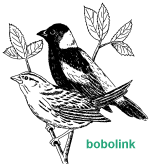 Plant or maintain several types of grasslands in your area. A mosaic of tall and short grass fields will provide habitat
diversity. If you can plant only one area to grass, a mixture of warm season grasses with forbs is best. Cool season grasses mixed with legumes is a second choice. Plant or maintain several types of grasslands in your area. A mosaic of tall and short grass fields will provide habitat
diversity. If you can plant only one area to grass, a mixture of warm season grasses with forbs is best. Cool season grasses mixed with legumes is a second choice.
- Create 100 ft shrub buffers next to forest edges and human habitations to reduce the harsh edge. An alternative to planting shrubs along the edge of a forest is to allow the fire to burn slowly into the woods so as to create a "feathered" edge. Local fire authorities should always be contacted prior to the burn to discuss permits and/or restrictions.
- Chemical treatments of grasslands can also be used to control woody plants.
Herbicides can be used to control any type of undesirable plants in your grassland, from wood plants to grasses and weeds. Correct application is most important. Damage of non-target vegetation or to wildlife is possible if you do not follow the herbicides label instructions. Michigan State University Extension Office can provide more information of the types, use, and applications of herbicides.
- Reducing or eliminating the use of insecticides will provide more valuable insect food for birds.
In summary, to attract grassland birds you need to provide the most grassland possible in your area. Reducing fragmentation, and restoring and enhancing existing grasslands will greatly benefit grassland birds. Working with your neighbors to maintain larger tracts of grasslands in your area will likely increase your success.
| The linked
map is an example that demonstrates the many management options
discussed throughout this chapter. The option(s) you choose should
depend not only on your goals, but the location, condition, and present
use of your land. |
Last Revised: December 12, 1999
|


 Grassland
habitats support a large variety of birds. Before European settlement, southern Michigan grasslands were largely dry
prairies, oak savannas, and wet meadows. During the settlement of Michigan, expansive, open prairies disappeared quickly as they were converted to farmland due to their rich soils. Wet meadows were drained and also made into productive agriculture lands. Michigan once had 70,000 acres of
upland prairies and 350,000 acres of wet prairies. Today, they have been reduced to fewer than 2,000 acres.
Grassland
habitats support a large variety of birds. Before European settlement, southern Michigan grasslands were largely dry
prairies, oak savannas, and wet meadows. During the settlement of Michigan, expansive, open prairies disappeared quickly as they were converted to farmland due to their rich soils. Wet meadows were drained and also made into productive agriculture lands. Michigan once had 70,000 acres of
upland prairies and 350,000 acres of wet prairies. Today, they have been reduced to fewer than 2,000 acres.